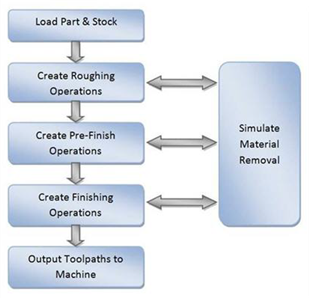The manufacturing process aims to successively reduce material from the stock model until it reaches the final shape of the designed part model. To accomplish this, the machinist or programmer utilizes a 3-part machining strategy.
1.A typical machining strategy employed in the manufacturing industry is to use larger cutters to perform bulk removal of material early on in the manufacturing process. These operations are called roughing operations. 2.This is then followed by operations employing successively smaller cutters removing proportionately smaller amounts of material from the stock model. This is done until the part has a uniform amount of stock left. These operations are called pre-finishing operations. 3.This is then followed by finish operations. Here the uniform stock remaining on the part is removed by using a small cutter removing a constant amount of material with every motion to produce the net shape. The standard work flow of TURN Module mimics this process and can be represented by the flow chart shown below. |
 TURN Module Work Flow Chart |
1.Part geometry is imported into TURN Module via the various data interfaces provided in VisualCAD. A stock model representing the raw stock from which the part needs to be manufactured can then either be created using the various tools provided in TURN Module or imported. 2.You then determine the machining strategy to be used in manufacturing the part. This can be done by loading a previously saved manufacturing operation sequence or by creating a new one. This manufacturing strategy is represented by a sequence of machining operations in Turning. 3.You can also simulate material removal to visualize how the stock model will look at any time during the process. This provides valuable feedback that can help you choose the most appropriate machining strategy. 4.To create a new machining operation, select a tool followed by the type of toolpath to be created. You then selects the parameters to use for machining and then generates the toolpath. 5.Rough machining can be done by Roughing operations, using a turning tool with a relatively large nose radius. These rough operations can be followed by subsequent roughing operations, either using the same tool or a smaller tool. 6.Final finishing of the part can then be performed by using one or more Finishing operations. Finishing operations typically use tools with smaller nose radius so as to obtain a better surface finish and tighter tolerance levels. 7.Depending on the geometry of the part and/or machining operations desired, Groove Roughing, Groove Finishing, Follow Curve, Threading and the Hole-Making operations can be considered. After completing all the machining operations, the final part is cut off from the rest of the bar stock by using the Part-Off operation. 8.Once all of the operations are completed you can then go back and review the operation sequence, re-order operations if desired and output the toolpath for post-processing. The "Machining Operations Browser" can be used to manage these operations. |